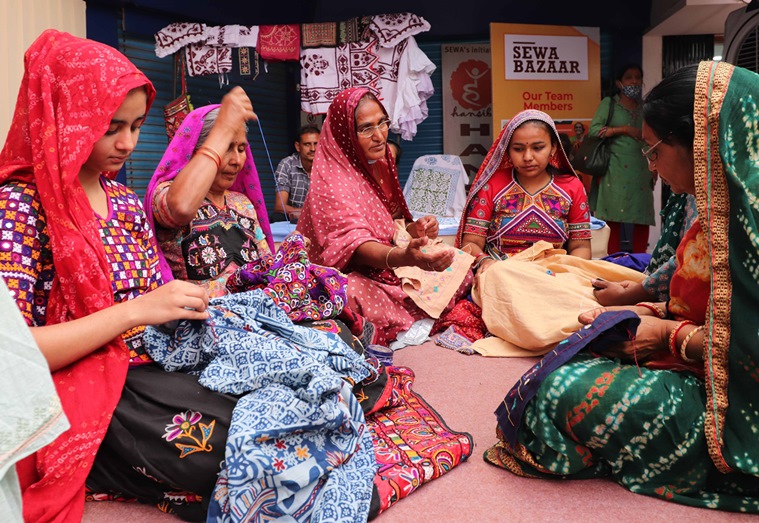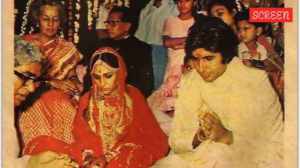A vision for women’s empowerment: the story of Ela Bhatt’s SEWA
The efforts of Ela Bhatt's SEWA to change the lives of over 2.1 million members — and many more around the world — has long been recognised as a model for the world.
 Ela Bhatt set up SEWA in 1972. (Express Archive)
Ela Bhatt set up SEWA in 1972. (Express Archive)SEWA, the Self Employed Women’s Association set up by Ela Bhatt in 1972, has achieved something that no company, conglomerate, or perhaps even government has achieved in India — the creation of a truly effective employment support programme for women who are among the country’s poorest and most marginalised.
Over 50 years, SEWA has built more than four dozen institutions for the poor and by the poor, and to empower poor women workers — all founded on the principle that “the poor do not need charity, they need an enabling mechanism to strive and come out of the vicious circle of poverty and vulnerability”.
SEWA, as Bhatt always said, is a trade union of women who “did not need to come together against anyone, they just needed to come together for themselves”. And by this act of coming together, these women gave themselves a voice.
The efforts of SEWA to change the lives of over 2.1 million members — and many more around the world — has long been recognised as a model for the world. Former United States first lady Hillary Clinton, and Cherie Blair, wife of former British Prime Minister Tony Blair, have visited SEWA and partnered with it.
Idea born of struggle
Bhatt, who passed away in Ahmedabad earlier this week, belonged to a family of freedom fighters — her grandfather had walked the Dandi March with Gandhi. Her ideology was shaped by the freedom movement, her training as a lawyer, through her association with the Textile Labour Association and experience of life in the slums, through her late husband Ramesh, an economist.
Ahmedabad, where she was born, and Surat, where she went to school — cities that were powered by the textile industry — partly charted her course. With its mass of migrant labour, Ahmedabad became her laboratory for organising the self-employed — with the poor women who did odd jobs to support themselves and their families at the core of her experiment.
The closure of two major textile mills in Ahmedabad in 1968 gave Bhatt her first insight into the extent of women’s involvement in running homes. As the men agitated for reopening the mills, the women worked to earn their families’ livelihoods. “They sold fruits and vegetables in the streets; stitched in their homes at piece-rate for middle-men; worked as labourers in wholesale commodity markets, loading and unloading merchandise; or collected recyclable refuse from city streets”, she wrote in her book, We Are Poor But So Many: The Story of Self-Employed Women in India.
Striking out on its own
SEWA was born out of the Textile Labour Association (TLA) — founded by Anasuya Sarabhai and Mahatma Gandhi in 1920 — but it could not register as a trade union until 1972 because its members did not have an “employer”, and were thus not seen as workers.
“Removing conceptual blocks” and “contesting pre-set ideas and attitudes of officials, bureaucrats, experts, and academics” was the most difficult part of SEWA’s journey, Bhatt wrote. “The hard-working chindi workers, embroiderers, cart-pullers, rag pickers, and forest produce gatherers can contribute to the nation’s gross domestic product… [But] Without an employer, you cannot be classified as a worker, and since you are not a worker, you cannot form a trade union.”
In 1981, after the anti-reservation riots in which the Bhatts were targeted for supporting quotas for Dalits in medical education, the TLA broke up with SEWA. “At the time of the break from the TLA, SEWA had 4,900 members, a small cooperative bank, an office building, a rural centre, one vehicle, and a few typewriters. But we also had a ten-year history of organizing. International unions promised us their support; national unions invited us to join them. But we wanted to stand on our own. We gathered all our strength and did not look back,” Bhatt wrote.
 SEWA, the Self Employed Women’s Association set up by Ela Bhatt in 1972.
SEWA, the Self Employed Women’s Association set up by Ela Bhatt in 1972.(Express Photo: Nirmal Harindran, File)
Women at centre, everywhere
With an annual membership fee of just Rs 10, SEWA allows anyone who is self-employed to become a member. Its network is spread across 18 Indian states, in other countries of South Asia, in South Africa, and Latin America.
It has helped rehabilitate women in personal, and even political or social crises, by empowering them through skilling and training. From embroiderers of Kutch and Banaskantha to rag-pickers and vegetable vendors in Ahmedabad, SEWA has brought them all in its tent. SEWA takes pride in the fact that women from diverse social and community backgrounds work together in the organisation. “We are taught not to discriminate on the basis of religion or caste,” the women say.
The organisation took a conscious decision to keep men out. Bhatt wrote, “Initially, I was open to the idea of men joining our union struggles, because I felt that they would lend more strength to SEWA; however, the women emphatically refused. They said they would feel inhibited with men around, and they believed men would dominate and create tensions.
“In addition, they felt that the issues that were important to women were different from those important to men. Another major but unspoken reason was that the women wanted to keep their earnings and savings private — if not secret — from the men.”
Pathbreaking initiatives
Of the small number of working women in India, as many as 94 per cent were self-employed in the informal sector, with no access to credit. As early as in 1974, SEWA Bank was established to provide small loans to poor women — an initiative that was recognised by the International Labour Organisation as a microfinance movement.
The Unorganised Workers Social Security Act (2008), the National Rural Livelihoods Mission (2011), and the Street Vendors Act (2014), are seen as successes of SEWA’s struggle. The PM Street Vendors Atmanirbhar Nidhi (PM-SVANidhi) scheme is seen as being inspired by SEWA’s microfinance model.
Among the many institutions launched by SEWA is a clothing line named after its oldest artisan, Hansiba from Radhanpur in Patan district, which has collaborated with French and British designers to take the ethnic embroidery of Gujarat to the world, through its own women. Hansiba collaborated with Sabah, a livelihood support organisation in Pakistan, to organise a fashion show in 2013. Apart from Delhi and Mumbai, Hansiba retails in Europe, Australia, the Americas, and Japan, and is a regular at the Santa Fe International Folk Art Market.
In Ahmedabad SEWA runs a cafe that serves affordable hot Gujarati and South Indian meals; it also sells vegetables grown in its farms, pulses, and spices. During the pandemic, SEWA launched Anubandh, an e-commerce platform to connect sellers with buyers, to keep kitchen fires burning through the lockdowns.


- 01
- 02
- 03
- 04
- 05




































